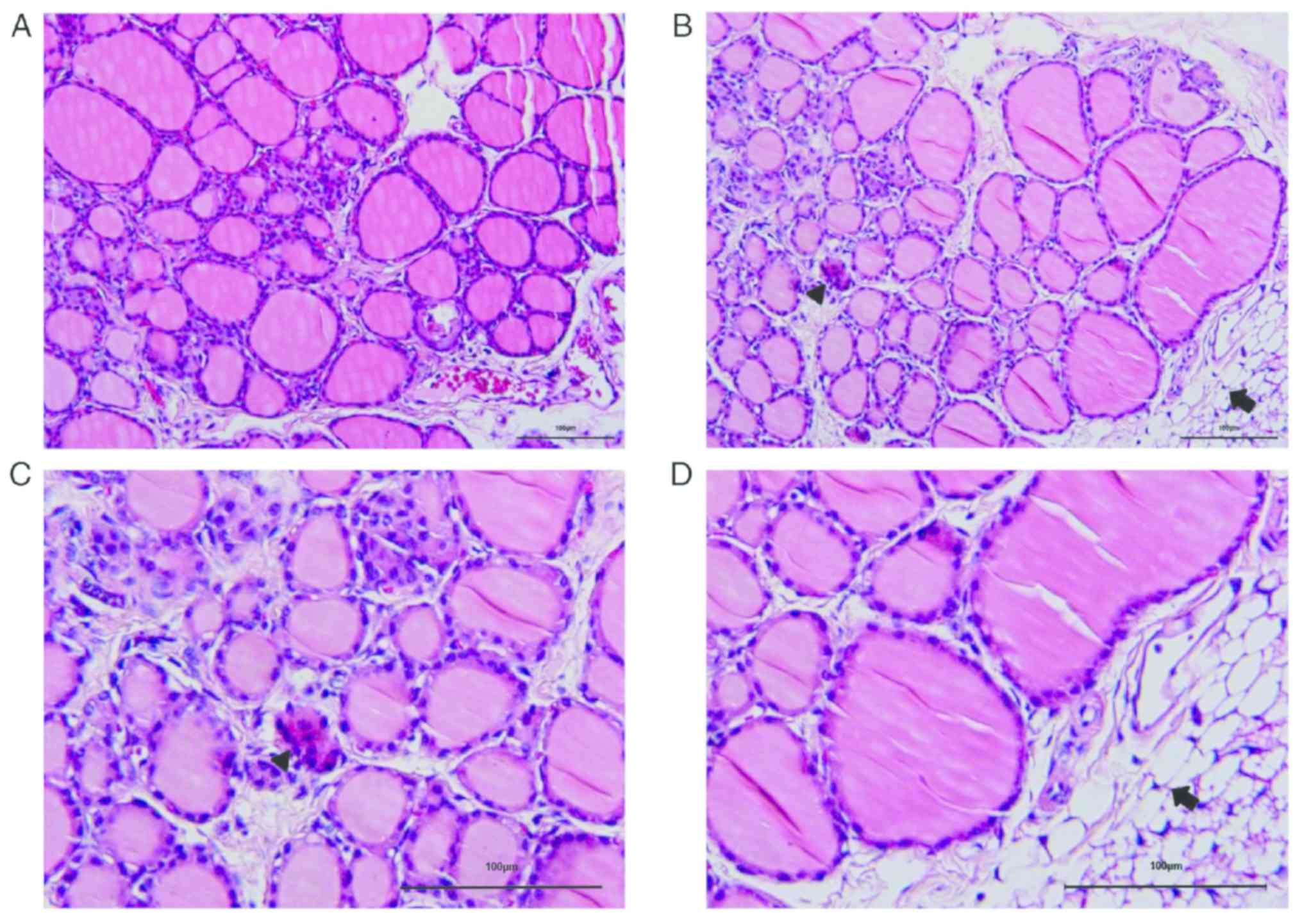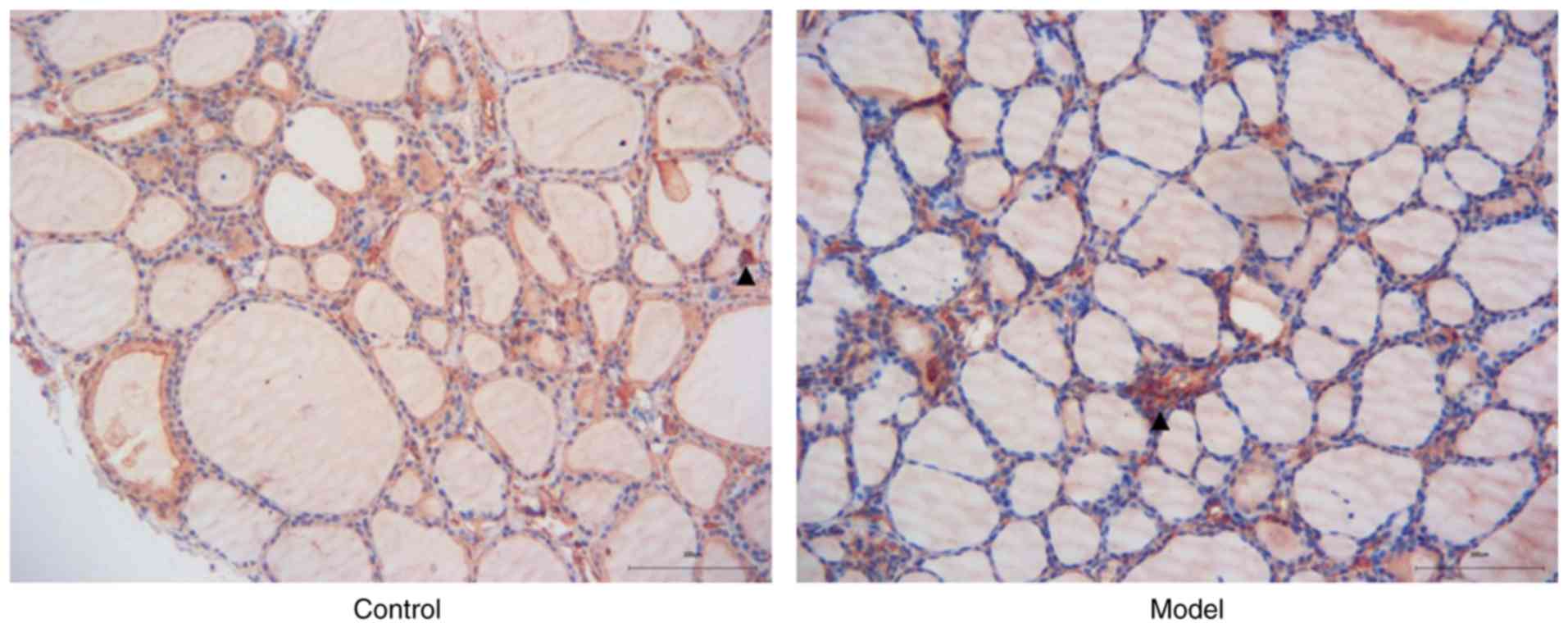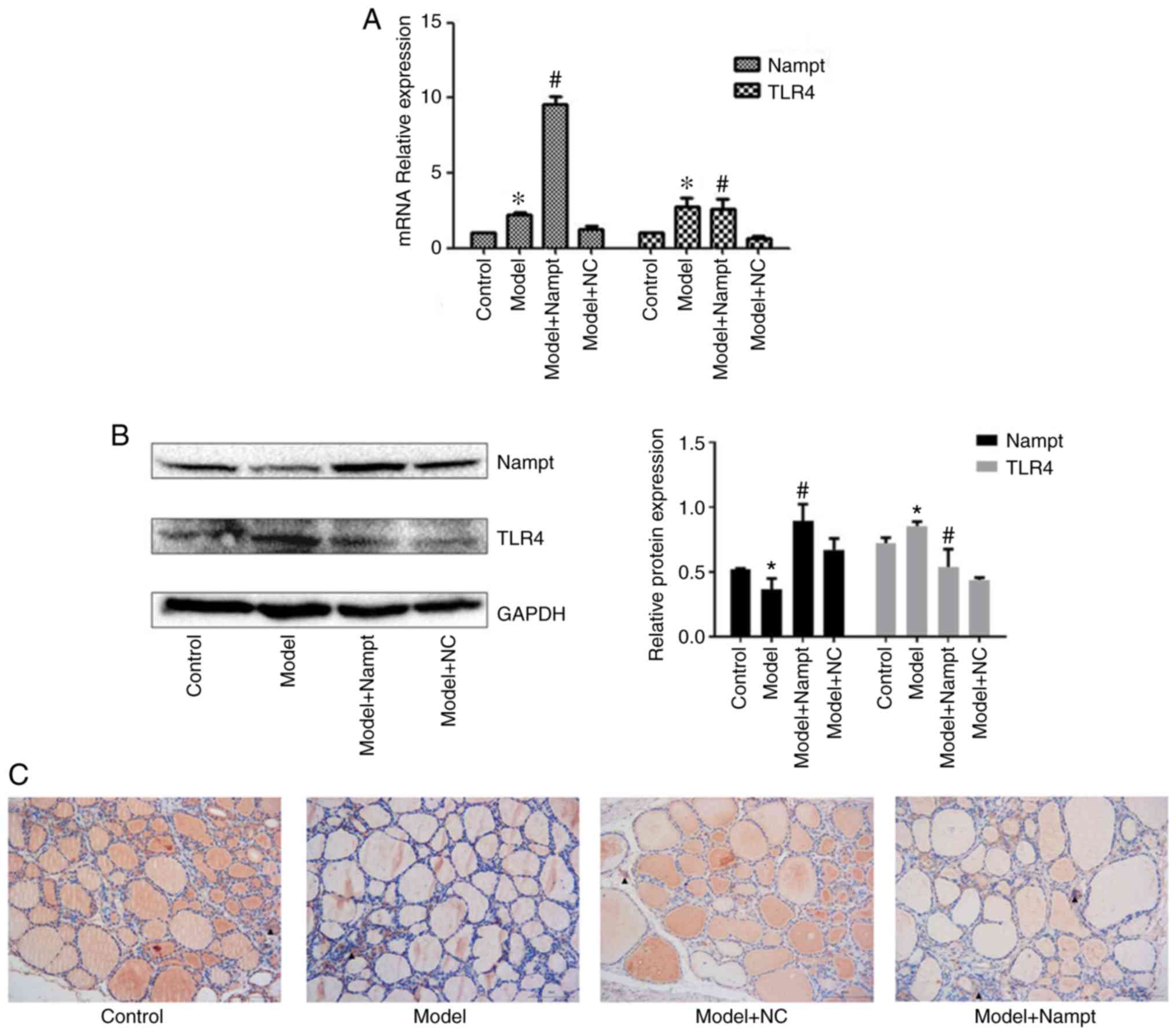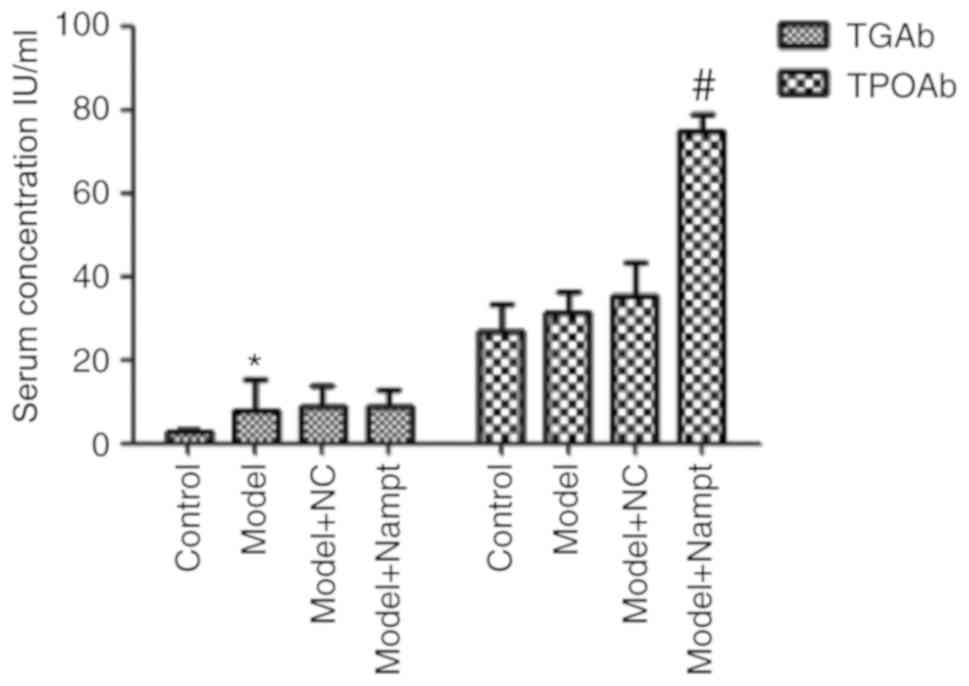|
1
|
Caturegli P, De Remigis A and Rose NR:
Hashimoto thyroiditis: Clinical and diagnostic criteria. Autoimmun
Rev. 13:391–397. 2014.PubMed/NCBI View Article : Google Scholar
|
|
2
|
Umar H, Muallima N, Adam JM and Sanusi H:
Hashimoto's thyroiditis following Graves' disease. Acta Med
Indones. 42:31–35. 2010.PubMed/NCBI
|
|
3
|
Ohye H and Sugawara M: Dual oxidase,
hydrogen peroxide and thyroid diseases. Exp Biol Med (Maywood).
235:424–433. 2010.PubMed/NCBI View Article : Google Scholar
|
|
4
|
Sawicka-Gutaj N, Zybek-Kocik A, Klimowicz
A, Kloska M, Mańkowska-Wierzbicka D, Sowiński J and Ruchała M:
Circulating visfatin in hypothyroidism is associated with free
thyroid hormones and antithyroperoxidase antibodies. Int J
Endocrinol. 2016(7402469)2016.PubMed/NCBI View Article : Google Scholar
|
|
5
|
Dahl TB, Holm S, Aukrust P and Halvorsen
B: Visfatin/NAMPT: A multifaceted molecule with diverse roles in
physiology and pathophysiology. Annu Rev Nutr. 32:229–243.
2012.PubMed/NCBI View Article : Google Scholar
|
|
6
|
Revollo JR, Grimm AA and Imai S: The
regulation of nicotinamide adenine dinucleotide biosynthesis by
Nampt/PBEF/visfatin in mammals. Curr Opin Gastroenterol.
23:164–170. 2007.PubMed/NCBI View Article : Google Scholar
|
|
7
|
Choi SE, Fu T, Seok S, Kim DH, Yu E, Lee
KW, Kang Y, Li X, Kemper B and Kemper JK: Elevated microRNA-34a in
obesity reduces NAD+ levels and SIRT1 activity by
directly targeting NAMPT. Aging Cell. 12:1062–1072. 2013.PubMed/NCBI View Article : Google Scholar
|
|
8
|
Garten A, Schuster S, Penke M, Gorski T,
de Giorgis T and Kiess W: Physiological and pathophysiological
roles of NAMPT and NAD metabolism. Nat Rev Endocrinol. 11:535–546.
2015.PubMed/NCBI View Article : Google Scholar
|
|
9
|
Sawicka-Gutaj N, Zybek-Kocik A, Kloska M,
Czarnywojtek A, Sowiński J, Budny B, Woliński K, Ziemnicka K,
Mańkowska-Wierzbicka D and Ruchała M: Determinants of
visfatin/NAMPT serum concentration and its leukocyte expression in
hyperthyroidism. Horm Metab Res. 50:653–660. 2018.PubMed/NCBI View Article : Google Scholar
|
|
10
|
Sawicka-Gutaj N, Andrusiewicz M,
Czarnywojtek A, Waligórska-Stachura J, Biczysko M, Skrobisz J,
Sowiński J and Ruchała M: Changes of nicotinamide
phosphoribosyltransferase expressions in thyroid glands of patients
with different thyroid pathologies. Biomed Res Int.
2018(1316390)2018.PubMed/NCBI View Article : Google Scholar
|
|
11
|
Sawicka-Gutaj N, Budny B, Zybek-Kocik A,
Sowiński J, Ziemnicka K, Waligórska-Stachura J and Ruchała M:
Nicotinamide phosphoribosyltransferase leukocyte overexpression in
Graves' opthalmopathy. Endocrine. 53:497–504. 2016.PubMed/NCBI View Article : Google Scholar
|
|
12
|
Ozkaya M, Sahin M, Cakal E, Yuzbasioglu F,
Sezer K, Kilinc M and Imrek SS: Visfatin plasma concentrations in
patients with hyperthyroidism and hypothyroidism before and after
control of thyroid function. J Endocrinol Invest. 32:435–439.
2009.PubMed/NCBI View Article : Google Scholar
|
|
13
|
Han J, Zhang TO, Xiao WH, Chang CQ and Ai
H: Up-regulation of visfatin expression in subjects with
hyperthyroidism and hypothyroidism is partially relevant to a
nonlinear regulation mechanism between visfatin and
tri-iodothyronine with various concentrations. Chin Med J (Engl).
125:874–881. 2012.PubMed/NCBI
|
|
14
|
Li JB and Li YB: The relationship between
visfatin and autoimmune thyroid disease. Labeled Immunoassays Clin
Med. 17:355–358. 2010.PubMed/NCBI View Article : Google Scholar
|
|
15
|
Livak KJ and Schmittgen TD: Analysis of
relative gene expression data using real-time quantitative PCR and
the 2(-Delta Delta C(T)) method. Methods. 25:402–408.
2001.PubMed/NCBI View Article : Google Scholar
|
|
16
|
Bi TQ and Che XM: Nampt/PBEF/visfatin and
cancer. Cancer Biol Ther. 10:119–125. 2010.PubMed/NCBI View Article : Google Scholar
|
|
17
|
Chung CP, Long AG, Solus JF, Rho YH, Oeser
A, Raggi P and Stein CM: Adipocytokines in systemic lupus
erythematosus: Relationship to inflammation, insulin resistance and
coronary atherosclerosis. Lupus. 18:799–806. 2009.PubMed/NCBI View Article : Google Scholar
|
|
18
|
Li Y, Ke J, Peng C, Wu F and Song Y:
microRNA-300/NAMPT regulates inflammatory responses through
activation of AMPK/mTOR signaling pathway in neonatal sepsis.
Biomed Pharmacother. 108:271–279. 2018.PubMed/NCBI View Article : Google Scholar
|
|
19
|
Kong YY, Li GQ, Zhang WJ, Hua X, Zhou CC,
Xu TY, Li ZY, Wang P and Miao CY: Nicotinamide
phosphoribosyltransferase aggravates inflammation and promotes
atherosclerosis in ApoE knockout mice. Acta Pharmacol Sin.
40:1184–1192. 2019.PubMed/NCBI View Article : Google Scholar
|
|
20
|
Neubauer K, Bednarz-Misa I,
Walecka-Zacharska E, Wierzbicki J, Agrawal A, Gamian A and
Krzystek-Korpacka M: Oversecretion and overexpression of
nicotinamide phosphoribosyltransferase/pre-B colony-enhancing
factor/visfatin in inflammatory bowel disease reflects the disease
activity, severity of inflammatory response and hypoxia. Int J Mol
Sci. 20(pii: E166)2019.PubMed/NCBI View Article : Google Scholar
|
|
21
|
Dayan CM and Daniels GH: Chronic
autoimmune thyroiditis. N Engl J Med. 335:99–107. 1996.PubMed/NCBI View Article : Google Scholar
|
|
22
|
Grani G, Carbotta G, Nesca A, D'Alessandri
M, Vitale M, Del Sordo M and Fumarola A: A comprehensive score to
diagnose Hashimoto's thyroiditis: A proposal. Endocrine.
49:361–365. 2015.PubMed/NCBI View Article : Google Scholar
|
|
23
|
Ehlers M, Thiel A, Bernecker C, Porwol D,
Papewalis C, Willenberg HS, Schinner S, Hautzel H, Scherbaum WA and
Schott M: Evidence of a combined cytotoxic thyroglobulin and
thyroperoxidase epitope-specific cellular immunity in Hashimoto's
thyroiditis. J Clin Endocrinol Metab. 97:1347–1354. 2012.PubMed/NCBI View Article : Google Scholar
|
|
24
|
Medzhitov R, Preston-Hurlburt P and
Janeway CA Jr: A human homologue of the Drosophila Toll protein
signals activation of adaptive immunity. Nature. 388:394–397.
1997.PubMed/NCBI View
Article : Google Scholar
|
|
25
|
Arbour NC, Lorenz E, Schutte BC, Zabner J,
Kline JN, Jones M, Frees K, Watt JL and Schwartz DA: TLR4 mutations
are associated with endotoxin hyporesponsiveness in humans. Nat
Genet. 25:187–191. 2000.PubMed/NCBI View
Article : Google Scholar
|
|
26
|
Tatematsu M, Yoshida R, Morioka Y, Ishii
N, Funami K, Watanabe A, Saeki K, Seya T and Matsumoto M: Raftlin
controls lipopolysaccharide-induced TLR4 internalization and
TICAM-1 signaling in a cell type-specific manner. J Immunol.
196:3865–3876. 2016.PubMed/NCBI View Article : Google Scholar
|
|
27
|
Nogueira AV, Nokhbehsaim M, Eick S,
Bourauel C, Jäger A, Jepsen S, Cirelli JA and Deschner J:
Regulation of visfatin by microbial and biomechanical signals in
PDL cells. Clin Oral Investig. 18:171–178. 2014.PubMed/NCBI View Article : Google Scholar
|
|
28
|
Camp SM, Ceco E, Evenoski CL, Danilov SM,
Zhou T, Chiang ET, Moreno-Vinasco L, Mapes B, Zhao J, Gursoy G, et
al: Unique Toll-like receptor 4 activation by NAMPT/PBEF induces
NFκB signaling and inflammatory lung injury. Sci Rep.
5(13135)2015.PubMed/NCBI View Article : Google Scholar
|
|
29
|
Sun S, He M, VanPatten S and Al-Abed Y:
Mechanistic insights into high mobility group box-1 (HMGb1)-induced
Toll-like receptor 4 (TLR4) dimer formation. J Biomol Struct Dyn.
37:3721–3730. 2019.PubMed/NCBI View Article : Google Scholar
|
|
30
|
Taylor KR, Trowbridge JM, Rudisill JA,
Termeer CC, Simon JC and Gallo RL: Hyaluronan fragments stimulate
endothelial recognition of injury through TLR4. J Biol Chem.
279:17079–17084. 2004.PubMed/NCBI View Article : Google Scholar
|
|
31
|
Swaroop S, Sengupta N, Suryawanshi AR,
Adlakha YK and Basu A: HSP60 plays a regulatory role in
IL-1β-induced microglial inflammation via TLR4-p38 MAPK axis. J
Neuroinflammation. 13(27)2016.PubMed/NCBI View Article : Google Scholar
|
|
32
|
Smiley ST, King JA and Hancock WW:
Fibrinogen stimulates macrophage chemokine secretion through
Toll-like receptor 4. J Immunol. 167:2887–2894. 2001.PubMed/NCBI View Article : Google Scholar
|
|
33
|
Alba R, Bosch A and Chillon M: Gutless
adenovirus: Last-generation adenovirus for gene therapy. Gene Ther.
12 (Suppl 1):S18–S27. 2005.PubMed/NCBI View Article : Google Scholar
|
|
34
|
Bruzzone S, Fruscione F, Morando S,
Ferrando T, Poggi A, Garuti A, D'Urso A, Selmo M, Benvenuto F, Cea
M, et al: Catastrophic NAD+ depletion in activated T
lymphocytes through Nampt inhibition reduces demyelination and
disability in EAE. PLoS One. 4(e7897)2009.PubMed/NCBI View Article : Google Scholar
|


















